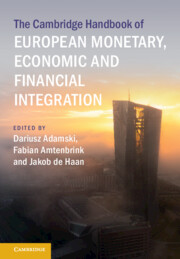Book contents
- The Cambridge Handbook of European Monetary, Economic and Financial Integration
- The Cambridge Handbook of European Monetary, Economic and Financial Integration
- Copyright page
- Contents
- Contributors
- Introduction
- Part I The Economic and Monetary Union
- Part II The Monetary Dimension
- Part III The Economic and Fiscal Dimensions
- 15 Reviving the Case for Policy Coordination in EMU
- 16 Ten Years of the European Semester
- 17 The EU Fiscal Rules
- 18 National Fiscal Policy in EMU
- 19 The Politics of Fiscal Integration in Eurozone Reforms and Next Generation EU
- 20 Adjustments in Economic Crises
- 21 Designing a Permanent EU-Wide Stabilization Facility
- 22 Enhancing Private and Public Risk Sharing
- Part IV Financial Integration
- Index
- References
20 - Adjustments in Economic Crises
The Different Outcomes of the Sovereign Debt and Pandemic Crises in Europe
from Part III - The Economic and Fiscal Dimensions
Published online by Cambridge University Press: 28 September 2023
- The Cambridge Handbook of European Monetary, Economic and Financial Integration
- The Cambridge Handbook of European Monetary, Economic and Financial Integration
- Copyright page
- Contents
- Contributors
- Introduction
- Part I The Economic and Monetary Union
- Part II The Monetary Dimension
- Part III The Economic and Fiscal Dimensions
- 15 Reviving the Case for Policy Coordination in EMU
- 16 Ten Years of the European Semester
- 17 The EU Fiscal Rules
- 18 National Fiscal Policy in EMU
- 19 The Politics of Fiscal Integration in Eurozone Reforms and Next Generation EU
- 20 Adjustments in Economic Crises
- 21 Designing a Permanent EU-Wide Stabilization Facility
- 22 Enhancing Private and Public Risk Sharing
- Part IV Financial Integration
- Index
- References
Summary
The European Union has introduced two different financial institutions for helping Member States to adjust to two crises with similar systemic implications. The European Stability Mechanism (ESM) for adjusting to the sovereign debt crisis of the early 2010s and the Recovery and Resilience Facility (RRF) for recovering from the pandemic crisis’s economic consequences of early 2020s. In less than a decade, in facing two crises with similar economic implications, the EU moved from an approach of ‘unconstrained intergovernmentalism’ (ESM) to an approach of ‘constrained supranationalism’ (RRF), although the ESM is a permanent institution while RRF is a pro tempore one (lasting until December 2026). In moving from one to the other approach, policy learning is considered to have been a crucial factor. While the European Central Bank has been instrumental in managing both crises, the chapter’s focus is on post-crisis economic (and not monetary) adjustment. It thus examines the role of national governments and supranational actors in the establishment and governance of different financial instruments for helping Member States to recover from economic crises.
- Type
- Chapter
- Information
- Publisher: Cambridge University PressPrint publication year: 2023
References
- 2
- Cited by



